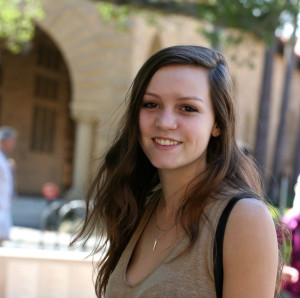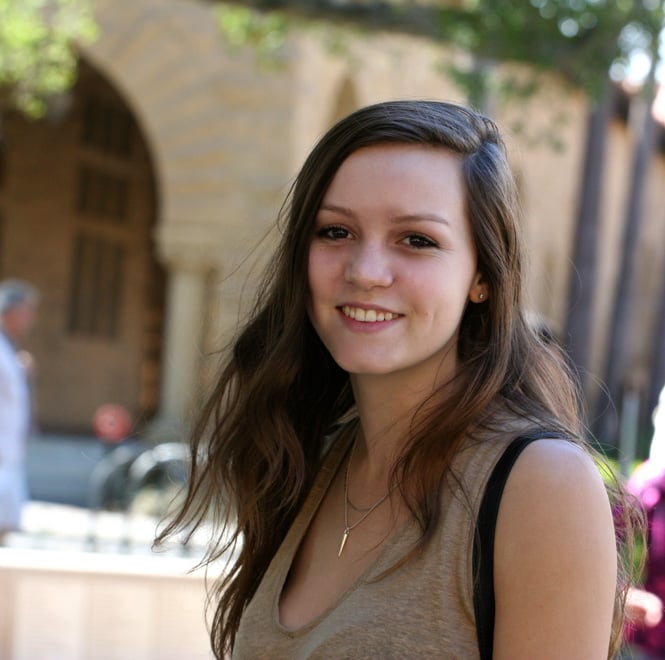
Margaux Giles ’19 might be the CEO of an up-and-coming startup with the potential to vastly improve natural disaster relief efforts, but she and her co-founders are used to not being taken seriously.
“When three teenage girls walk in the room, usually the reaction isn’t, ‘Oh look, professionals,’” said Giles, the co-founder of Disaster Mesh. “There’s always that skepticism up front. We’re constantly having to go through the process of being questioned — answering those questions and having the person be like, ‘Okay, they do know what they’re talking about.’”
That isn’t something most people in the tech world have to go through, Giles said.
Disaster Mesh aims to create mesh networks that can be airdropped by drone into disaster areas, enabling survivors to contact each other and disaster responders. Giles and her co-founders just won a partnership with Verizon that will help fund the project, and while they’ve rehearsed their responses to common questions, they’re used to being interrogated about the startup.
Giles thinks part of the reason she and her co-founders are constantly being questioned so much is that they’re young. But she suspects it also has to do with their being female. She and the Disaster Mesh co-founders have sometimes found themselves feeling out of place in a male-dominated tech world, with labels applied to them because they are an anomaly.
“We’re just three founders that happen to be young and women,” Giles said. “We don’t really need those labels.”
But at the same time, Giles and her co-founders realize those labels can be used to their advantage: A startup headed by three young women can attract welcome attention precisely because it is so unusual.
“I feel like in some situations we’ve been able to walk in somewhere and have interest because of our firsthand image, and after that we prove that we deserve it and all that,” Giles said. “A lot of people will be like, ‘This would be a good image for us to link with.’”
Getting started
Although Giles has lived in San Francisco for the past eight years, she grew up in a distinctly “fuzzy” environment: At the bilingual French high school she attended, there were no computer science classes and little emphasis on technology.
Giles’s father, who is British, works in venture capital, but no one else in the family is involved in the tech world.
“Coming from the UK or from France, it’s not really a big field to get into,” said Giles, whose mother is French.
It was only around age 15 that Giles’s own interest in tech began. She decided to participate in the Technovation program, a “global technology entrepreneurship program” that gives girls the opportunity to build apps.
While in the program, Giles was assigned to a female mentor who was a recruiter for Airbnb, and she remembers spending several weekends working at the Airbnb headquarters, using software called App Inventor to drag blocks of code together.
It was the first time she had been exposed to a distinctly tech environment, and she liked it. After that, though, she felt rather out of place at her school because she was one of the few students interested in tech.
Her interest “wavered” a bit, she said, but was renewed in summer 2014 when she participated in a program at Singularity University, a Silicon-Valley based corporation that aims to teach people — mainly adults — about how to implement cutting-edge technologies to help others.
Participants in the youth pilot program spend two weeks working on their own projects in groups. Since Giles got along well with her roommate, Karla Dana, they decided to work together. One of the two other girls in the program, Katelyn Dunn, approached them and asked to join.
But to their surprise, some others in the program had a problem with the makeup of their group.
“Some people in the program were telling us, ‘Oh, you guys aren’t diverse enough. You can’t just have three girls — you should incorporate some of the guys,’” Giles said. “We didn’t, in the end. It ended up being just the three of us, and it worked perfectly.”
The project
Together, the three came up with the novel idea of creating a “disaster mesh” — a network of physical nodes in which each node is a device that could be dropped into an area in the case of a disaster. The maple-seed-shaped devices could be transported via drone and would allow survivors to communicate with each other, disaster responders and loved ones.
The nodes would form a mesh network, a network in which the nodes themselves work together to distribute data, and as a result, the devices would be able to communicate with each other even if there is no Wi-Fi or cellular data in the area. The Disaster Mesh network will show up on phones and laptops like any other network, and survivors will be directed to a landing page where they can provide information about themselves, their location and their needs.
Disaster responders in the area will also be able to see information on the network and use it to find survivors. In addition, if a single seed is able to connect to a satellite, survivors will be able connect to the Internet and communicate with the outside world.
“It grew out of conversations with different people,” Giles said. “One of the participants [at Singularity University] was a survivor of the Chilean earthquake of 2010, so we had tons of conversations with her. She kind of pointed us in the right direction.”
Dana, who is from Mexico, had heard stories of natural disasters from relatives, and Giles herself has relatives in the south of France who often lose Internet connectivity during annual floods.
“I would love for them to be able to use [Disaster Mesh] to communicate,” Giles said.
The project received positive feedback at Singularity, and Giles, Dana and Dunn had the opportunity to take it to a Maker Faire in Rome — a gathering at which innovators show off technologies and projects they have made. With off-the-shelf parts, the girls built five “seeds” they could use to demonstrate the mesh network in miniature.
Each prototype “seed” is about the size of a shoe and includes mini solar panels as well as USB ports people can use to charge their devices. Hopefully, the final version will be about four inches long so they can drift down over a disaster area and will also include a physical button for people in distress to push if they don’t have phones, Giles said.
The seeds currently cost about $20 each to make, but the cost is expected to go down as the price of solar panels drops. The material for the seeds is not yet set in stone, but the founders are considering carbon fiber or foam casing.
Since none of the co-founders had any background working in hardware or engineering, and their software experience was still somewhat limited, they relied on online protocols and other people at Singularity to help them figure things out.
“Once we got there [to Maker Faire] and showed what we had done, we got even more of a positive response,” Giles said. “At that point we were sure that we didn’t want to stop.”
Moving forward
Giles and her co-founders have continued working on Disaster Mesh, largely focusing on making contacts in the tech world and among people working in disaster relief organizations. They got their first patent in the fall of 2014.
This spring, Disaster Mesh was a finalist in a Federal Emergency Management Agency competition called “Design4Disasters.” Not winning was “a bit disheartening,” Giles said, but she and the other founders have continued working on the project nevertheless. They participated in the Bay Area Maker Faire last May and entered the Verizon Powerful Answers competition in June, and won a partnership with Verizon.
According to Giles, they know they’ll be receiving funding from the company soon but are not sure how much. They’re hoping to hire an engineer who can build a prototype of the network that can be test-deployed. Currently, they’re focusing on making contacts and finding partnerships.
Giles explained that it’s hard with her co-founders’ being far apart and having to work online, in addition to their being full-time students. Dunn is in high school in Las Vegas, and Dana goes to Long Island University Global, a traveling university. Giles estimates that they spend 10 to 20 hours per week collaborating.
“It’s really hard to balance everything,” Giles said. “I’ve been thinking about what I should do next — if I need to take some time off for myself and what I should be focusing on. I’m not giving my all to my classes, and I’m not giving my all to Disaster Mesh, and that’s a struggle with myself.”
Despite the challenges, Giles said she loves Stanford so far. She’s planning to major in product design and still somehow finds time to play on the women’s rugby team, which she said gives her a welcome break from everything else.
“Apart from being busy, I really love it here,” Giles said. “Sometimes you get stressed or overwhelmed, but you walk outside, and the weather’s so nice, and everything’s so beautiful. It’s great.”
Contact Emma Johanningsmeier at ejmeier ‘at’ stanford.edu.
